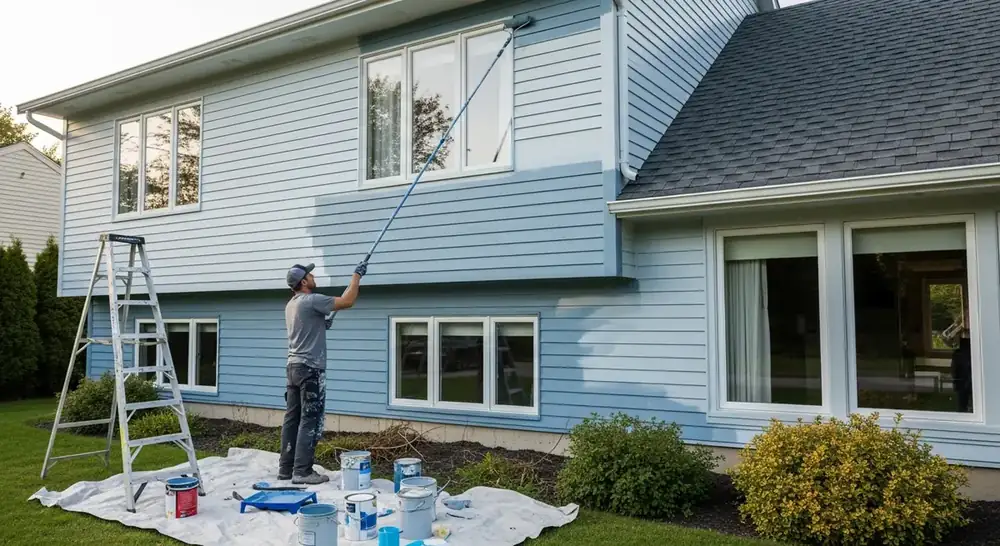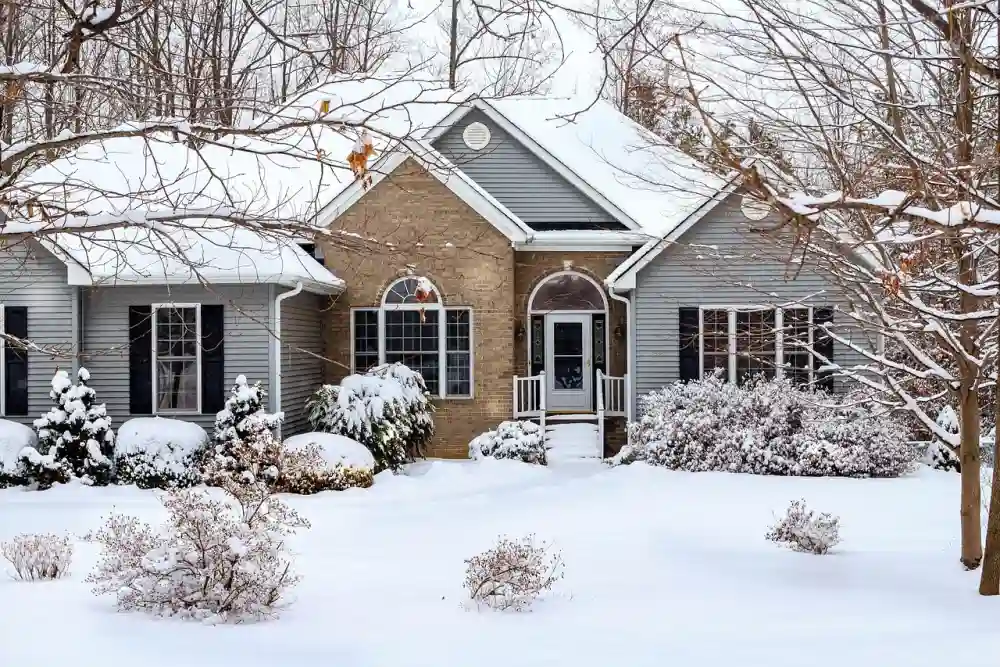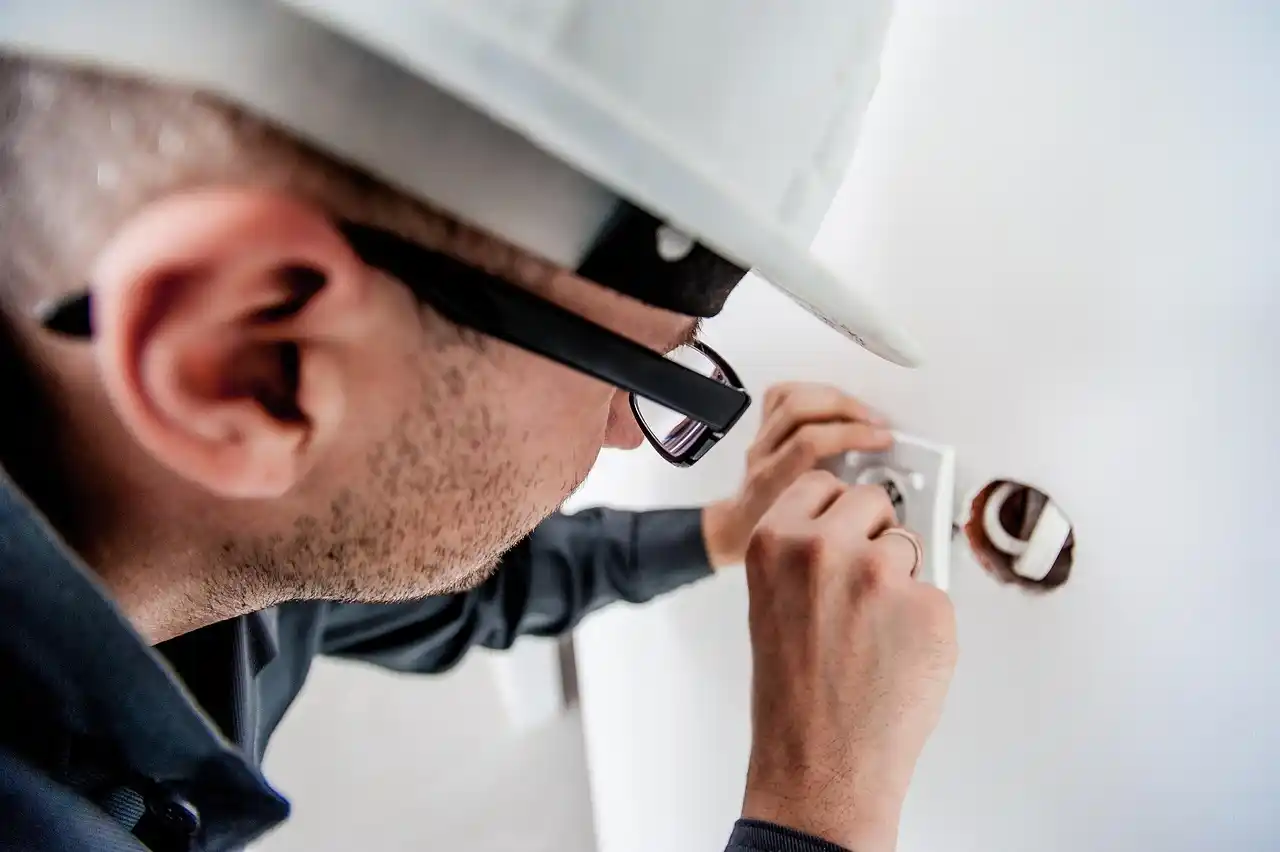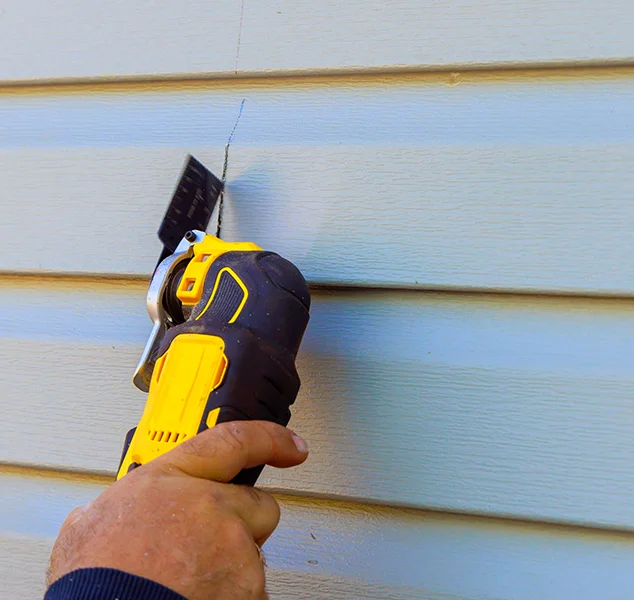Can You Paint Aluminum Siding? Tips for Painting Your Home's Exterior
Can you paint aluminum siding? Absolutely—and painting aluminum siding represents one of the most cost-effective home exterior updates available, transforming dated appearances for fraction of replacement costs. Aluminum siding dominated home construction from the 1940s through 1980s, leaving millions of homes with faded, chalky, or simply outdated color schemes that diminish curb appeal and property values. While replacement with modern vinyl or fiber cement siding costs $8,000-25,000, professional painting delivers dramatic improvements for $3,000-7,000, while DIY approaches cost even less. Understanding proper preparation, paint selection, and application techniques ensures painted aluminum siding looks beautiful and performs well for 10-20 years, making this upgrade an intelligent investment for Northern Virginia homeowners.
Why Paint Aluminum Siding?
Aluminum siding paint projects address multiple problems simultaneously. Factory finishes on aluminum siding fade dramatically after 20-30 years of UV exposure, leaving homes with washed-out, unattractive appearances. Chalking—where paint oxidizes creating powdery surface coating—makes siding look dingy while transferring white residue to anything touching it. Original color choices from decades past often feel dated, making homes appear older than necessary. Painting solves all these issues while providing opportunity to update colors matching current design trends.
Beyond aesthetics, painting protects aluminum from corrosion and extends siding life significantly. Modern paints formulated specifically for metal surfaces provide superior weather protection compared to aged factory finishes. Quality paint jobs last 10-20 years depending on exposure, climate, and maintenance—dramatically longer than many homeowners expect. For homes with structurally sound aluminum siding showing cosmetic age, painting delivers excellent value compared to complete replacement. This cost-effective approach mirrors decisions homeowners face with siding replacement versus refurbishment across all material types.

Assessing Whether Your Aluminum Siding Can Be Painted
While most aluminum siding accepts paint successfully, certain conditions require attention first. Inspect siding thoroughly for structural damage—dents, deep scratches, holes, or corrosion through the aluminum. Minor cosmetic issues work fine under paint, but significant damage may warrant replacement rather than painting. Check for loose or detached panels requiring reattachment before painting. Examine trim, corners, and J-channels for deterioration indicating underlying problems.
Test existing finish adhesion by applying duct tape to clean, dry siding and pulling it off sharply. If significant paint comes off with tape, existing coating requires complete removal before repainting—a major project potentially making replacement more economical. Look for previous paint failures—peeling, bubbling, or flaking indicating preparation or paint quality issues requiring correction. Aluminum siding in good structural condition with intact but aged factory finish represents ideal painting candidates. Homes with extensive damage, multiple previous paint failures, or severe corrosion should consider replacement instead.
Choosing the Right Paint for Aluminum Siding
Paint selection critically affects aluminum siding painting success and longevity. Premium 100% acrylic latex paints formulated for metal surfaces provide best results, offering superior adhesion, flexibility, and weather resistance. Products like Sherwin-Williams Duration, Benjamin Moore Aura, or Behr Premium Plus Exterior specifically designed for metal applications outperform standard exterior paints. Expect to spend $50-70 per gallon for quality paint—worthwhile investment ensuring longevity and appearance.
Acrylic paints flex with aluminum's thermal expansion and contraction, preventing cracking and peeling. They resist chalking, maintaining color and gloss longer than cheaper alternatives. Self-priming formulas simplify application, though separate metal primers often deliver superior results especially on bare aluminum or heavily weathered surfaces. Choose colors carefully—lighter colors reflect heat reducing thermal stress on siding while hiding minor imperfections better than dark colors. Many paint manufacturers offer warranties on metal applications when using specified products and following proper preparation procedures. These paint considerations mirror material selection decisions when planning siding replacements or major exterior updates.

Surface Preparation: The Critical Success Factor
Surface preparation determines painting success more than any other factor. Inadequate preparation causes 90% of paint failures on aluminum siding. Start by thoroughly cleaning all surfaces removing dirt, mold, mildew, and especially chalky oxidation. Power washing works well at moderate pressure (1,200-1,500 PSI) using wide fan tips maintaining 12+ inches from siding. Add TSP (trisodium phosphate) or specialized metal siding cleaners to wash water for enhanced cleaning power.
After washing, allow siding to dry completely—minimum 48 hours in warm, dry weather. Sand glossy surfaces lightly with fine-grit sandpaper (220-320 grit) creating tooth for paint adhesion. Remove any loose or peeling paint completely through scraping and sanding. Fill dents and holes with auto body filler or exterior-grade metal filler, sanding smooth after curing. Prime bare aluminum or areas with removed paint using quality metal primer. Mask windows, doors, trim, and other areas requiring protection. This meticulous preparation takes longer than painting itself but ensures results lasting years rather than failing prematurely.
Application Techniques for Professional Results
Proper application technique delivers professional-quality results whether using brushes, rollers, or sprayers. Spray application using airless sprayers provides fastest, most uniform coverage ideal for large areas. Maintain consistent distance (12-16 inches) and overlap patterns by 50% preventing thin spots. Use quality tips sized appropriately for your paint—typically .015-.019 for exterior paints. Back-roll sprayed surfaces with paint roller ensuring paint works into siding texture for superior adhesion.
Brush and roller application takes longer but works excellently for homeowners without spray equipment or for detail work around trim and windows. Use high-quality brushes (2.5-3 inch angled brushes for cutting in, 4-inch for flat areas) and thick-nap rollers (3/8-1/2 inch) designed for textured surfaces. Apply paint in thin, even coats working in manageable sections. Maintain wet edges preventing lap marks from sections drying before adjacent areas receive paint. Two coats provide better coverage, color depth, and longevity than single thick coats. These application principles apply similarly when coordinating exterior painting with professional versus DIY approaches to siding work.

Weather and Timing Considerations
Northern Virginia's climate demands strategic timing for aluminum siding painting. Late spring through early fall provides ideal conditions—temperatures between 50-85°F with low humidity and minimal precipitation. Avoid painting in direct sunlight when surface temperatures exceed 90°F, as excessive heat causes paint to dry too quickly preventing proper adhesion and leveling. Don't paint when temperatures will drop below 50°F within 48 hours after application, as cold interferes with curing.
Check extended weather forecasts ensuring 2-3 days of dry weather for painting and initial curing. Morning starts allow completing sections before afternoon heat while ensuring overnight temperatures don't fall below minimums. Spring and fall offer moderate temperatures ideal for painting, though pollen in spring requires extra cleaning before and during work. Summer works well for patient homeowners willing to start early or work later avoiding mid-day heat. Winter painting proves problematic in Virginia—save this project for warmer months ensuring optimal conditions supporting paint performance and longevity.
Cost Analysis: Painting vs. Replacement
Understanding costs helps homeowners make informed decisions between painting and replacing aluminum siding. Professional painting typically costs $1.50-3.50 per square foot including preparation, primer, two coats of quality paint, and labor. Average 2,000 square foot home exteriors cost $3,000-7,000 depending on condition, complexity, and local rates. DIY painting costs $500-1,500 for materials, tools, and equipment rental while requiring 40-80 hours of labor over several weekends.
Replacement with vinyl siding costs $4-9 per square foot installed ($8,000-18,000 for typical homes), while fiber cement runs $6-12 per square foot ($12,000-24,000). Painting delivers 40-70% cost savings versus replacement while transforming appearance comparably. However, painting every 10-15 years over 30-year period costs more cumulatively than one-time replacement with 30-50 year materials. The decision depends on timeline, budget, and plans for the home. Homeowners staying 5-15 years benefit from painting's lower initial cost, while those planning decades of ownership might prefer replacement's long-term value. These economic considerations mirror decisions when evaluating repair versus replacement across various situations.

Common Painting Mistakes to Avoid
Several mistakes undermine aluminum siding painting projects, causing premature failure or poor appearance. Inadequate surface preparation tops this list—skipping thorough cleaning, failing to remove chalk completely, or not priming bare metal creates adhesion failures within months. Using cheap paint saves money initially but costs more through early failure requiring complete repainting. Painting in poor weather conditions—too hot, too cold, too humid—prevents proper curing creating weak paint films prone to failure.
Applying paint too thickly trying to achieve coverage in one coat causes runs, sags, and slow curing. Multiple thin coats outperform single thick applications consistently. Neglecting to back-roll sprayed paint reduces adhesion significantly. Failing to maintain wet edges creates visible lap marks ruining appearance. Painting over dirt, mildew, or failing paint without correction guarantees problems. Avoiding these common errors ensures successful projects delivering beautiful, durable results justifying time and expense invested.
Primer Selection and Application
While some premium paints claim self-priming properties, separate primers often improve results significantly on aluminum siding. Oil-based or alkyd primers provide excellent adhesion to metal surfaces, creating superior foundation for topcoats. Products like Zinsser Cover Stain, Kilz Original, or Benjamin Moore Fresh Start Metal Primer excel on aluminum. These primers seal porous oxidized surfaces, block stains, and provide uniform base for topcoats.
Acrylic metal primers offer easier cleanup and faster drying than oil-based products while delivering excellent performance. They're ideal for aluminum in good condition with minimal oxidation or previous paint. Apply primer following same techniques as topcoat—thin, even coverage with proper overlap. Allow complete drying per manufacturer recommendations before topcoating. Primer investment—adding $200-500 to project costs—pays dividends through improved adhesion, better coverage, and extended coating lifespan. Skipping primer on properly prepared aluminum risks adhesion problems that compromise entire project.

Color Selection Strategies
Choosing colors for painted aluminum siding involves aesthetic preferences, practical considerations, and potential resale impacts. Lighter colors reflect heat reducing thermal stress on aluminum while hiding minor imperfections and chalking better than dark colors. They also resist fading longer than deep hues requiring less frequent repainting. However, light colors show dirt more readily than medium tones requiring more frequent cleaning for maintained appearance.
Consider architectural style when selecting colors. Traditional homes benefit from classic neutrals—grays, tans, whites, and muted earth tones. Contemporary designs support bolder choices including deep charcoals, rich blues, or warm terracottas. Coordinate siding color with fixed elements—roof color, brick or stone features, and landscape colors. Test paint samples on actual siding viewing them at different times of day in various light conditions before committing. Many paint retailers offer large sample sizes or small trial quantities enabling accurate previewing. Remember that painted aluminum can be repainted more easily than replacing siding—bold choices can be changed more readily than permanent installation decisions. Color selection impacts curb appeal similarly to choosing materials for roof painting projects or other exterior updates.
Maintenance of Painted Aluminum Siding
Painted aluminum siding requires minimal but important maintenance ensuring longevity and appearance. Annual washing with mild detergent removes dirt, pollen, and organic growth preventing degradation. Use soft brushes or cloths with gentle pressure—harsh scrubbing or pressure washing above 1,500 PSI can damage paint films. Address mildew promptly with appropriate cleaners preventing extensive growth requiring more aggressive treatment.
Inspect painted surfaces annually for damage, checking for chips, scratches, or peeling requiring touch-up. Address small problems immediately preventing expansion—touching up 10 square feet costs minimal time and materials while preventing deterioration spreading across entire walls. Trim vegetation maintaining 12-18 inches clearance from siding, improving air circulation and reducing organic growth. Clean gutters regularly preventing overflow that splashes dirty water onto siding. These simple maintenance practices preserve painted aluminum's appearance and protection for 15-20 years before requiring complete repainting. Regular maintenance principles apply similarly to understanding vinyl siding care and other exterior surfaces.

Professional vs. DIY: Making the Right Choice
Deciding between professional painting services and DIY depends on several factors. DIY saves $2,500-5,500 in labor costs while providing satisfaction of personal accomplishment. Homeowners comfortable with ladders, possessing adequate time (expect 40-80 hours over 2-4 weeks), and willing to invest in or rent equipment can achieve excellent results. DIY works particularly well for smaller homes or single-story structures minimizing ladder work and physical demands.
Professional painting makes sense for large homes, multi-story structures, or homeowners lacking time, equipment, or physical ability for demanding work. Professionals complete typical homes in 3-7 days, bringing experience identifying problems, quality equipment, and insurance protecting against damage. They achieve more uniform results than most DIY attempts while eliminating homeowner risk from ladder work and chemical exposure. Many homeowners adopt hybrid approaches—handling preparation work themselves while hiring professionals for priming and finish coating. Understanding personal capabilities honestly and evaluating time availability helps make appropriate decisions maximizing value while ensuring quality results.
Environmental and Health Considerations
Modern paints offer low-VOC (volatile organic compound) and zero-VOC formulations reducing environmental impact and health concerns during application. These products perform excellently while minimizing odor and emissions that caused problems with older paints. Choose products certified by Green Seal or meeting EPA standards for reduced environmental impact. Proper disposal of paint, solvents, and contaminated materials protects environment—never pour paint down drains or discard improperly.
Protect yourself during painting with appropriate safety equipment. Respirators or masks rated for paint fumes prevent inhaling harmful vapors. Chemical-resistant gloves protect skin from paint and solvents. Safety glasses shield eyes from splashes and drips. Ensure adequate ventilation when painting near windows and doors. Follow all product safety instructions, understanding proper handling, storage, and disposal procedures. These environmental and safety practices protect you, your family, and community while achieving excellent painting results.

When Replacement Makes Better Sense
While painting aluminum siding delivers excellent value in many situations, replacement sometimes provides better long-term solutions. Severely damaged siding with extensive dents, corrosion, or loose panels costs more to repair and paint than replacing. Homes requiring complete rewiring, insulation upgrades, or structural repairs benefit from siding removal providing access while eliminating painting investment on material destined for disposal. Aluminum siding with multiple previous paint failures likely suffers underlying adhesion problems that new paint won't solve permanently.
Homeowners planning 20+ years in homes might prefer replacement's longer lifespan over painting's 10-15 year durability. Modern vinyl or fiber cement siding offers superior insulation, lower maintenance, and contemporary aesthetics that painted aluminum cannot match. When painting costs approach 50% of replacement costs—often occurring with extensive damage requiring repair—replacement provides better value. Professional assessment helps determine whether painting or replacing makes better economic and practical sense for specific situations. Understanding when painting works versus when replacement proves superior ensures homeowners make informed decisions maximizing value. Similar evaluations apply when considering comprehensive exterior updates including coordinating with roof replacement projects.
Expert Guidance from Reston Roof
While Reston Roof specializes in roofing systems, we understand home exterior components work together creating comprehensive protection and appearance. We can recommend trusted painting contractors specializing in aluminum siding projects, ensuring you receive quality service when updating your home's exterior. Our experience with exterior building envelope systems helps homeowners understand how painting projects coordinate with roofing work, trim replacement, and other exterior improvements maximizing value through strategic planning.
When planning exterior updates, consider timing painting projects with roofing work, avoiding scheduling conflicts while leveraging scaffolding and access equipment across multiple projects. Our team helps homeowners develop comprehensive exterior improvement plans addressing all systems systematically rather than piecemeal approaches missing coordination opportunities. Whether you need expert roof repairs, complete roof replacement, or guidance coordinating exterior improvements, we provide professional service throughout Northern Virginia. We serve Reston, Herndon, Sterling, Fairfax, and surrounding communities. Contact us at (571) 453-6515 to discuss your roofing needs and learn how comprehensive planning protects your home investment most effectively.
